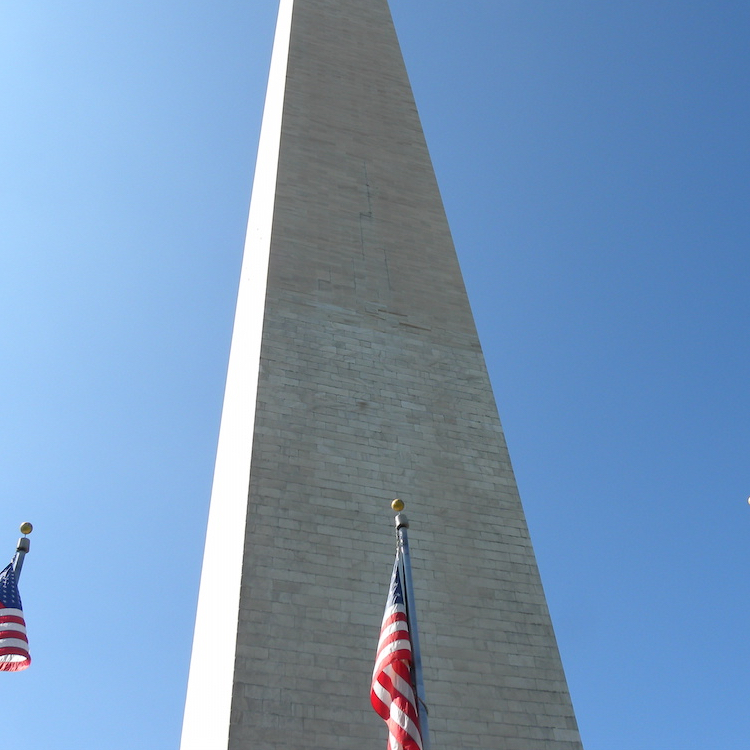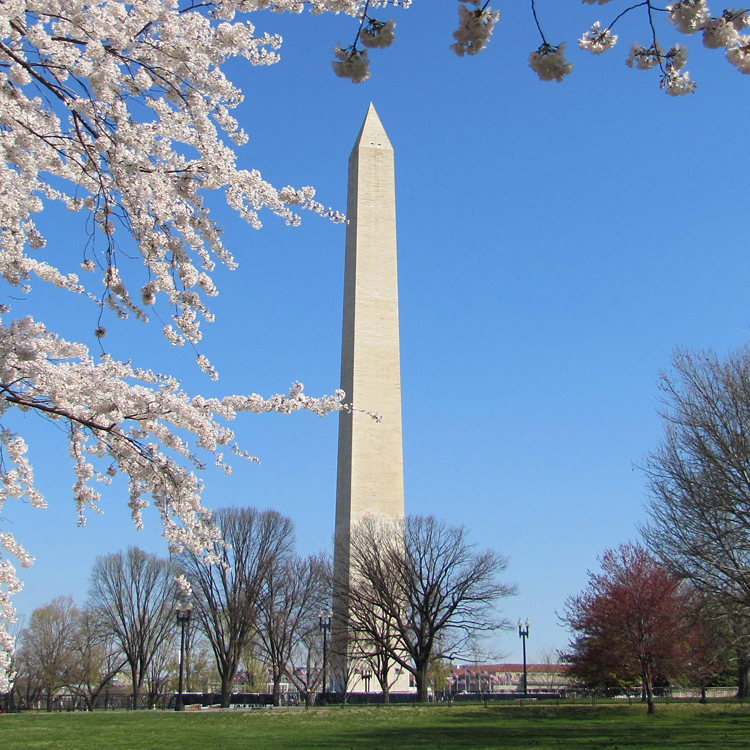The Know-Nothings’ involvement in Washington Monument history includes far more than the 1854 theft of the Pope’s stone. The very next year, in fact, the Know-Nothings took over the Washington National Monument Society itself, in a disputed election.
On February 22, 1855, the Society held another annual meeting in the council chamber of the old city hall. By now, such meetings seldom had more than a dozen members show up. This time it would be different. The voting opened at 11 AM and closed at 1 PM—at which point 755 votes had been cast. The Society now had a brand new set of officers, all of them Know-Nothings. Almost all of them received 755 votes, too. The exception was the new acting leader, the new First Vice-President Vespasian Ellis, who got 754. Mr. Ellis was already fairly well-know around Washington. In 1854 he had founded a local Know-Nothing newspaper, the American Organ, which lasted until 1857.
It was obvious how the ballot-box stuffing had been done. Anyone could become a member by paying one dollar. The change of ownership was duly reported the next day in the February 23, 1855 [page 2] Organ. One of the first things the new leadership did was to restrict voting to members who were native-born or naturalized Americans. The society expressed its hope that it could finish the Monument in two more years.
The February 23, 1855 [page 3] issue of another local newspaper, the Evening Star, took a critical view of such antics: “…the election which came off yesterday is null and void…”, and “…the regular election does not take place until the 22 of February, 1856.” The Star added, “We are informed that the clerk had no authority to publish the advertisements ordering the election.” This clerk was to figure prominently in the ensuing disputes.
Over the next few months, the Organ and the Star would conduct a running editorial battle with each other. This sort of newspaper feuding can be a gold mine to historians. The Organ was quick off the mark in its response. Referring to the Star only as “one of the papers of this city”, the February 26, 1855 [page 2] Organ argued that the previous Board had held no gatherings from 1835 to 1849, and no elections since 1849.
The February 26 Organ went on to complain in long-winded detail, as was its custom. For example, when the new ( Know-Nothing ) Board had shown up on February 24 to hold another meeting, the old Board had shown up too, to conduct a meeting of its own. The old Board also refused to hand over its books and papers. Not surprisingly, “Some discussion ensued as to the legality of the election…and some little feeling was manifested on each side, but no serious difficulty was created.
The Star would soon dispute the Organ’s “no serious difficulty.”
This writer has visited the basement level of the Old City Hall where such meetings were held. The original rooms are still there—-about the size of an average kitchen, and poorly ventilated as well. It must have been crowded, not to mention stuffy, for both societies to hold their meetings there at the same time, perhaps trying to talk over each other.
Moving into another topic, the February 26 Organ defiantly rejected any financial help from Congress. On February 22, the U.S. Congress, for the first time, had been about to vote a badly-needed $200,000 for the Monument. They dropped the idea after the Know-Nothings took over, so the Organ’s announcement may have been putting the best face on things—the idea had been canceled, anyway.
Referring to “Sam” a nickname for the Know-Nothings, the February 26 Organ finally concluded by adding, “If the nephew ‘Sam’ can’t do it, after a fair trial, then and not until then, let ‘Uncle Sam’ be called for assistance.” Prophetic words.
Later that same busy day, the February 26, 1855 [page 2] Star had an article claiming the Know-Nothings did use force at the February 24 double meeting, and had tried to use force to seize the old association’s property, even bringing along a mob of 70 or 80 to do it. Next day, the 27th [page 2], the Organ denied it, sneering at ‘these miserable assaults of the Star.”
The Star counterattacked on March 2 [page 2], defending the old Board, who were willing to take the dispute for settlement to the District Court. The Star also editorialized that it would rather see the Monument unfinished, than be competed by a group opposed to equal rights. The March 3 [page 2] Organ blew its top, in a reply jammed full of italics and exclamation points. One of the calmer portions read, “Fraud indeed!”
On March 10, things began to get physical. Early that morning, the old superintendent, Mr. William Dougherty, had walked over to his office at the Monument grounds. Soon after, a Know-Nothing officer named S.S. Briggs showed up and handed Dougherty a notice that there was a new superintendent, namely, S.S. Briggs. Not surprisingly, Mr. Dougherty wasn’t going anywhere, unless they threw him out.
There was more to come. The May 29, 1855 [page 1] Star went after F.W. Eckloff, the clerk. It turned out the only notice of the election had been published the day before, in the February 21 Organ, Star, and the local Daily National Intelligencer. Presumably, at least some regular members missed the news, or couldn’t attend on such short notice. Also, only the Secretary could send out notices.
The May 29 Star also enlarged on the alleged threats made during the February 24 double meeting. The old Board had shown up first. Mr. Eckloff handed them a letter from Ellis, warning the old group to keep their hands off society records. The same article went on to describe other efforts at Know-Nothing intimidation. On March 7, three days before Dougherty faced down Briggs, Dougherty had received a Know-Nothing letter warning him not to call on the Washington Monument watchman for collections made by visitors. Dougherty wrote back, rejecting the order.
On the 8th, with Dougherty absent, the Know-Nothings got the keys to the grounds from the day watchman, Mr. George Hill. Dougherty got another key from mr. Hilton, and unlocked several buildings on the grounds. He then re-locked the doors, and nailed them up. Later that evening, the doors were broken open, and the locks changed. Mr. Dougherty would be in just the right mood for his March 10 encounter with Briggs.
On the 12th, Dougherty, along with Peter Force, went back to the Monument grounds, found it occupied by the Know-Nothings, and was indeed thrown out.
The Star attacks must have sent Mr. Ellis’ anger to new levels. By August 31, the Organ was reduced to accusing Dougherty of mutilating a Tennessee gift stone, allegedly carving off three slabs from its back for table tops. Dougherty angrily responded in the September 2 Star, denying the charge of vandalism—though he did admit he had a sample of each state block available.
Things were quite for the rest of 1855. Then, on May 7, 1856 [page 2], the Star gleefully reported how the Know-Nothings had already given up on construction for that year: “Their working season is much shorter than any ever heard of in this section of the country.” The Star archly added that under the old Board the Monument “had risen to within three and a [half] feet of its present height.” These 3 ½ feet, by the way, were made of rejected marble that lay about the grounds, and later had to be removed. Yes, snickered the Star, the Know-Nothings “were to send it up into the clouds with a jerk.”
On April 25, 1857 [pages 2 and 3], the Star wrote of how the financial records of the Know-Nothing Board were thoroughly confused.
On October 20, 1858, the Know-Nothings, already fading away as a political movement, quietly turned back control to the old Board. The October 21, 1858 Star covered the changeover matter-of-factly——no gloating [page 3].
There is an irony in the restoration of the old Board. Mr. William Dougherty, who had proved so stubborn in keeping the Society’s papers from the Know-Nothings, took those papers with him when he moved south as the Civil War broke out. He died in Tennessee in 1867, and some of the papers were never found.
In some historical accounts, the Know-Nothings are blamed for gaps in the Monument’s early records. They may have their share of the blame, but so does Mr. Dougherty.





